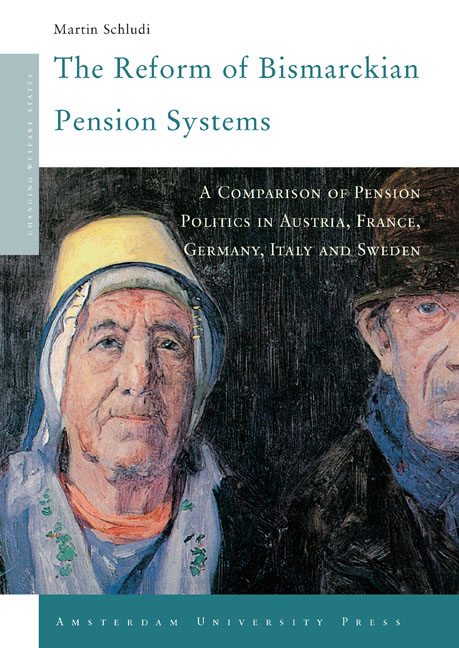 The Reform of Bismarckian Pension Systems
The Reform of Bismarckian Pension Systems Book contents
- Frontmatter
- Contents
- List of Tables/List of Figures
- Acknowledgements
- Introduction
- 1 The Need for Pension Reform:A Problem-Oriented Perspective
- 2 An Empirical Overview of Policy Change in Bismarckian Pension Regimes
- 3 The Politics of Pension Reform:An Actor-Centred Explanatory Framework
- 4 Sweden:Policy-Oriented Bargaining
- 5 Italy:Corporatist Concertation in the Shadow of EMU
- 6 Germany:From Consensus To Conflict
- 7 Austria:Reform Blockage by the Trade Unions
- 8 France:Adverse Prerequisites for a Pension Consensus
- 9 Conclusion
- Appendix I Summary Description of Retirement Systems (1986)
- Appendix II Chronology of National Pension Reforms
- Appendix III Glossary of Terms
- Notes
- Bibliography
- Index
5 - Italy:Corporatist Concertation in the Shadow of EMU
Published online by Cambridge University Press: 24 January 2021
- Frontmatter
- Contents
- List of Tables/List of Figures
- Acknowledgements
- Introduction
- 1 The Need for Pension Reform:A Problem-Oriented Perspective
- 2 An Empirical Overview of Policy Change in Bismarckian Pension Regimes
- 3 The Politics of Pension Reform:An Actor-Centred Explanatory Framework
- 4 Sweden:Policy-Oriented Bargaining
- 5 Italy:Corporatist Concertation in the Shadow of EMU
- 6 Germany:From Consensus To Conflict
- 7 Austria:Reform Blockage by the Trade Unions
- 8 France:Adverse Prerequisites for a Pension Consensus
- 9 Conclusion
- Appendix I Summary Description of Retirement Systems (1986)
- Appendix II Chronology of National Pension Reforms
- Appendix III Glossary of Terms
- Notes
- Bibliography
- Index
Summary
Key features of the Italian pension system in the late-1980s
The Italian pension system provides for old age, disability, and survivors’ benefits. It is divided into a number of mostly public occupational schemes. Private schemes are usually only of rudimentary significance. There are four types of public schemes:
1 a general scheme for dependent workers;
2 schemes for the self-employed;
3 schemes for civil servants;
4 schemes for special occupational groups, some of which complement the general scheme.
In addition, there is a means-tested social pension for people over age 65 with insufficient resources who are not eligible for benefits under any of the other schemes.
The benefit structure and the level of benefits vary greatly from scheme to scheme. Dependent workers insured under the general scheme receive a maximum pension of 80% of their earnings during the last five years up to a certain ceiling, after 40 years of contributions. The minimum contribution period is 15 years. The standard retirement age is 55 for women and 60 for men. However, people with a contribution record of at least 35 years are entitled to a “seniority pension” irrespective of their age.
The self-employed are not entitled to earnings-related pensions. Instead, their pensions are based on the actuarial revaluation of their contributions. No pension, however, can be lower than an established minimum. The age requirement is 65 for men and 60 for women, and the minimum contribution period is 15 years.
Civil servants enjoy earnings-related pensions, with a replacement rate of 80% after 40 years service; this rate may reach 100% for certain categories. Civil servants must retire at 65, but a pension may be claimed, regardless of age, after 20 years’ service, and in some cases after only 15 years’ service.
All pensions are linked to the minimum contractual industrial wage.
The general scheme operates on a pay-as-you-go basis and is financed through earnings-related contributions paid by employers (two-thirds) and employees (one-third). Together these amount to about 24% of earnings. The self-employed pay a flat-rate contribution, whereas civil servants pay an earnings-related contribution of around 7%.
- Type
- Chapter
- Information
- The Reform of Bismarckian Pension SystemsA Comparison of Pension Politics in Austria, France, Germany, Italy and Sweden, pp. 109 - 128Publisher: Amsterdam University PressPrint publication year: 2005


